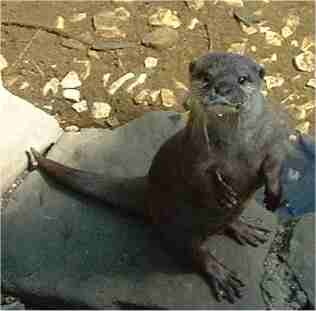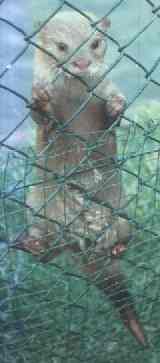Locomotion of the Asian Small-Clawed Otter
In Water
The Asian Small-Clawed Otter is a less proficient swimmer than other otters. This is partly because their paw webbing is incomplete, and partly because they are less streamlined in shape than might be expected.
When in the water, these animals normally doggy-paddle around fairly slowly, using all four legs. They will swim faster, as much as 1.2m/s, in very short bursts, undulating the whole body from the shoulders, with the forelegs tucked up to the chest ( Chanin 1985).
On Land

 As a rule, these animals run along the ground in the characteristic otter bounding run, caused by having hind legs longer than their forelegs. When alarmed, and prevented
from reaching water, they can move faster than a person can run, turn in their own length and squeeze through seemingly impossible gaps, shouldering aside considerable weights effortlessly (Pers. Obs.). They make more use of the tripod stand than other otters, probably because they are so small, and can, and will hop along for short distances on their hind legs. They tend to carry objects between one paw and the cheek or chest, and readily cover large distances on three paws. Bedding tends to be carried in the mouth alone, with the head held high.
As a rule, these animals run along the ground in the characteristic otter bounding run, caused by having hind legs longer than their forelegs. When alarmed, and prevented
from reaching water, they can move faster than a person can run, turn in their own length and squeeze through seemingly impossible gaps, shouldering aside considerable weights effortlessly (Pers. Obs.). They make more use of the tripod stand than other otters, probably because they are so small, and can, and will hop along for short distances on their hind legs. They tend to carry objects between one paw and the cheek or chest, and readily cover large distances on three paws. Bedding tends to be carried in the mouth alone, with the head held high.
One surprising side effect of being paw-oriented is that Asian Small-Clawed Otters are excellent climbers. They are able to grip with surprising strength, and rapidly haul themselves through shrubs and anything else they can grasp. They can also jump at least two feet into the air (Pers. Obs.), enabling them to scramble up rocks and over barriers.
| Asian Small-Clawed Otter |

